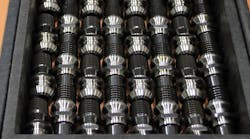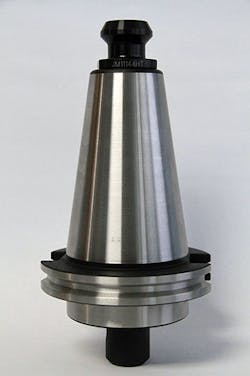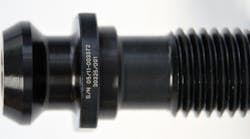For decades, the U.S. has been “bleeding” manufacturing jobs to overseas companies. Now, a less-than-$100 part that some say is robbing machining operations of 20-30% in productivity may be the key to changing that equation. Having lost so many order for low-cost parts, U.S. manufacturers have been largely relegated to short-order production runs of more complex, precision parts for aerospace, medical devices, and Tier 2 and 3 automotive customers.
For this type of work, half million-dollar CNC milling machines are programmed to cut alloys using extremely precise positioning coordinates. Every component part – from spindle to toolholder and cutting tool – is finely balanced and perfectly mated together to withstand rotation of up to twenty-thousand revolutions per minute with little or no runout.
However, despite attention to almost every aspect of the machine, one critical part has been largely overlooked. Namely, the retention knob that attaches to the threaded end of tapered toolholders to engage with the drawbar, which exerts a pull force that holds the toolholder firmly in the spindle.
When tightened, poorly designed retention knobs can bulge the toolholder imperceptibly at the small end of the taper, preventing full contact and proper seating of the toolholder in the spindle. This slows cutting speeds, affects tolerances and precision, shortens tool life and even increases power consumption.
Yet despite widespread evidence that this occurs in the form of uneven toolholder wear patterns and simple “touch-off” tests, manufacturers as a whole largely ignore the issue. Given that approximately 570,000 V-flange milling machines are in operation today throughout the U.S., and with even conservative estimates pegging productivity loss at 10-30%, the industry could be losing as much as $214 million per shift each year.
“Companies purchase top-of-the-line machining centers and the most expensive cutting tools, but they completely ignore the interface between them: the toolholder and the retention knob,” said Joe DaRosa, former president at Toyota Manufacturing of Texas and now an advisor to the automotive industry.
While this may seem like it belongs in the category of “too good to be true,” dismissing it outright without a closer examination could be foolhardy. Even 10-20% faster machining would dramatically reduce cycle times, the machining industries’ measure of the time it takes to make each part from start to finish.
Looked at from other angles, such an improvement would lower labor costs per part, allow for more competitive bids to win more jobs, increase profit margins, and eliminate the need to invest in more equipment/labor to meet the same production demands.
So, when DaRosa first learned about the issue with retention knobs and how it could affect productivity and tool life, he was immediately interested in learning more. “In my role as an executive, anything that could reduce costs or improve efficiency gets my attention,” said DaRosa,
The flaw in the design — According to John Stoneback of JM Performance Products, a manufacturer of CNC mill spindle optimization products, the problem with retention knobs began more than 40 years ago when the milling machines were first introduced. At that time, leading American manufacturers played a critical role in developing and standardizing the first V-flange milling machines, and little attention was placed on the length of the threads in the toolholder.
Stoneback said European and Japanese CNC equipment manufacturers recognized the value of a pilot to increase the rigidity of the tool, but no studies were conducted to ensure the optimal design. Much later, the world’s standards organizations fell in line and essentially adopted what had become the default standard for retention knobs.
“The world standards for retention knobs are not correct because they were put in place without adequate testing,” according to Stoneback. “The current design is costing the U.S. a fortune, mostly because the machining challenges it causes are pervasive, yet still not widely recognized as a problem.”
Stoneback has an interest in this topic, to be sure. In 2009 after learning of the widespread nature of the problem, he went to work and invented a High Torque retention knob that addresses this issue.
The High Torque retention knob is longer by design to reach deeper into the threaded bore of the toolholder. As a result, all thread engagement occurs in a region of the toolholder where there is a thicker cross-section of material to resist deformation.
The High Torque retention knob also includes a precision pilot to increase rigidity and is balanced by design. Since even over-tightening of the High Torque retention knobs can still create a bulge, the company provides specifically calculated torque specs based on drawbar pressure.
The product works with all existing toolholders including BT, DIN, ISO, and CAT toolholders from 30 to 60 taper.
By combining the High Torque retention knob with the correct torque, spindle contact with the taper is improved to close to 100% every time. This can be verified by simple, six-step “touch off” test. More sophisticated measurement of toolholder expansion (bulge) can also be taken using a taper shank test fixture.
Janos Garaczi, president of Delta Machine Company in Gardena, Calif., decided to use the retention knobs for machining hard materials like titanium and other exotic alloys. Delta Machine specializes in high -volume production of complex, tight-tolerance parts for medical and aerospace manufacturing.
Garaczi said the combination of equipment, High Torque retention knobs, and machining expertise has decreased cycle times as much as 40-50%, allowing Delta Machine to often outbid the competition for projects involving titanium.
“At the end of the day, we are able to run [titanium and stainless steel] much faster than most machine shops,” said Garaczi.
Even leading manufacturers of vertical and horizontal machining centers are recommending High Torque retention knobs for use on the equipment.
“We have seen many situations where retention knobs have been overtightened. A guy goes to the workbench and uses a wrench and a hammer to tighten the retention knob, and it is certainly not to the proper torque with this method. This ends up distorting the taper and so the tool does not seat in the taper correctly,” said Craig Gilsinger, applications/quality manager for CNC machine builder JTEKT Toyoda Americas for more than 20 years.
This can cause a multitude of problems that too often get blamed on the suppliers’ equipment: vibration and chatter, poor tolerances, non-repeatability, poor finishes, excessive spindle wear and tear, run-out, and shallow depths of cuts.
Extending Tool Life — Perhaps more than some other industries, medical and aerospace manufacturing can take a toll on the carbide cutting tools. When machining exotic alloys and hard metals, the cutters must be changed out more frequently as they dull or break. By increasing the rigidity of the toolholder at higher RPMs, the High Torque retention knob increases tool life.
“In aerospace, every shop is trying to machine parts faster and aggressively remove more stock, just to stay competitive. This just puts more pressure on the tool,” said Rex Ausbun at Cling’s Aerospace, a company that specializes in complex, four- and five-axis precision machined parts.
With higher-end technical carbide inserts, the cost of tool replacement, not to mention loss of production time due to frequent changeover, can add up quickly.
“Since we changed to the High Torque Retention Knobs, I’m not seeing any distortion in the toolholder taper,” said Ausbun, who estimated that tool costs have been reduced by as much as 20% as a result.
Changing manufacturing climate — Although automotive manufacturers are already benefitting from implementing the High Torque retention knobs, many consider it a competitive edge so keep the information close to the vest. Others remain unaware – even dismissive – that improper seating of tapered toolholders in the spindle is even a problem that has far reaching effects on machining.
Still, Stoneback believes the climate is shifting for U.S. manufacturing to increase its capability to compete for jobs that are higher in volume, spurring long-term employment and economic growth.
“When I was young, the U.S. made three times more manufactured parts than the rest of the world. That is not true anymore,” said Stoneback.
“President Trump wants to bring manufacturing jobs back to the U.S.,” he added. “The fastest way to do that is to increase productivity by resolving the hidden flaw in machining and become more competitive. Then, let’s go after all the parts we have lost overseas.”
Jeff Elliott is a Torrance, Calif.-based technical writer. He has researched and written about industrial technologies and issues for the past 20 years.









